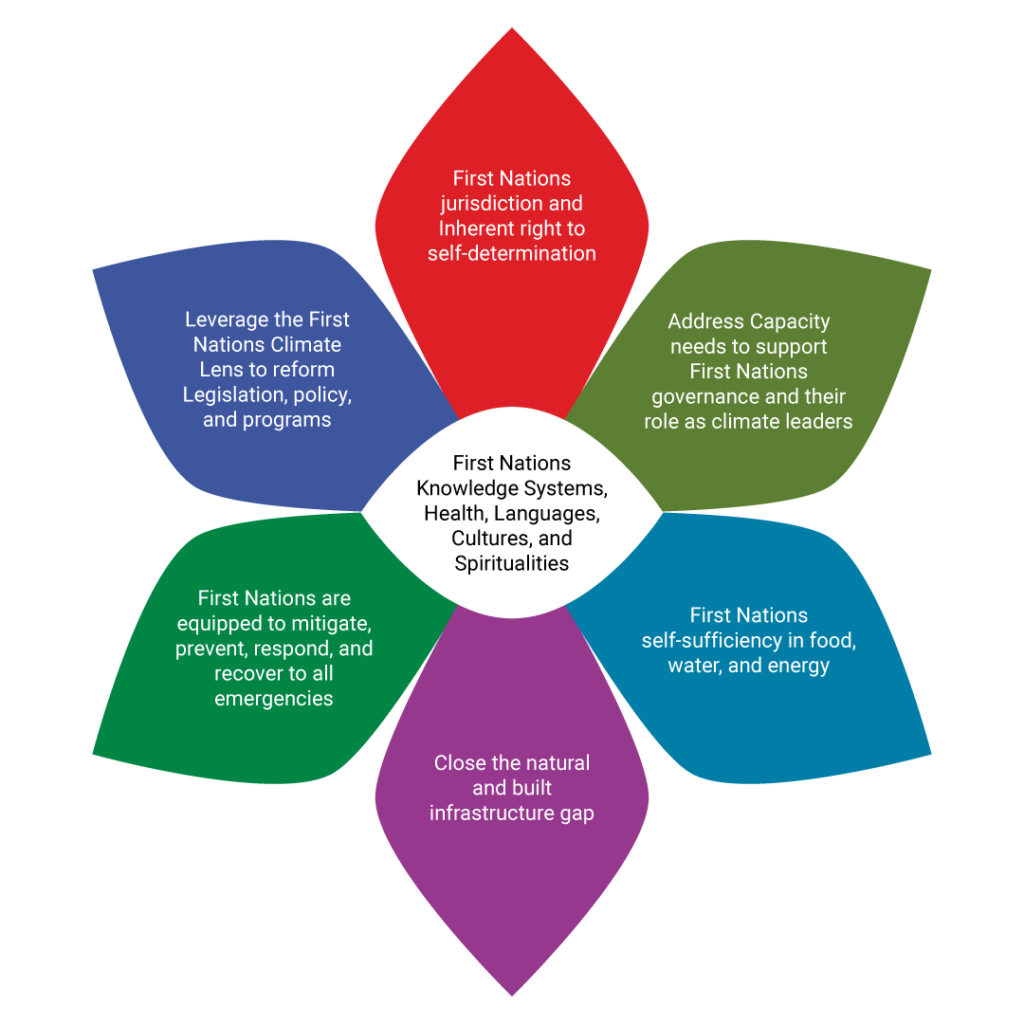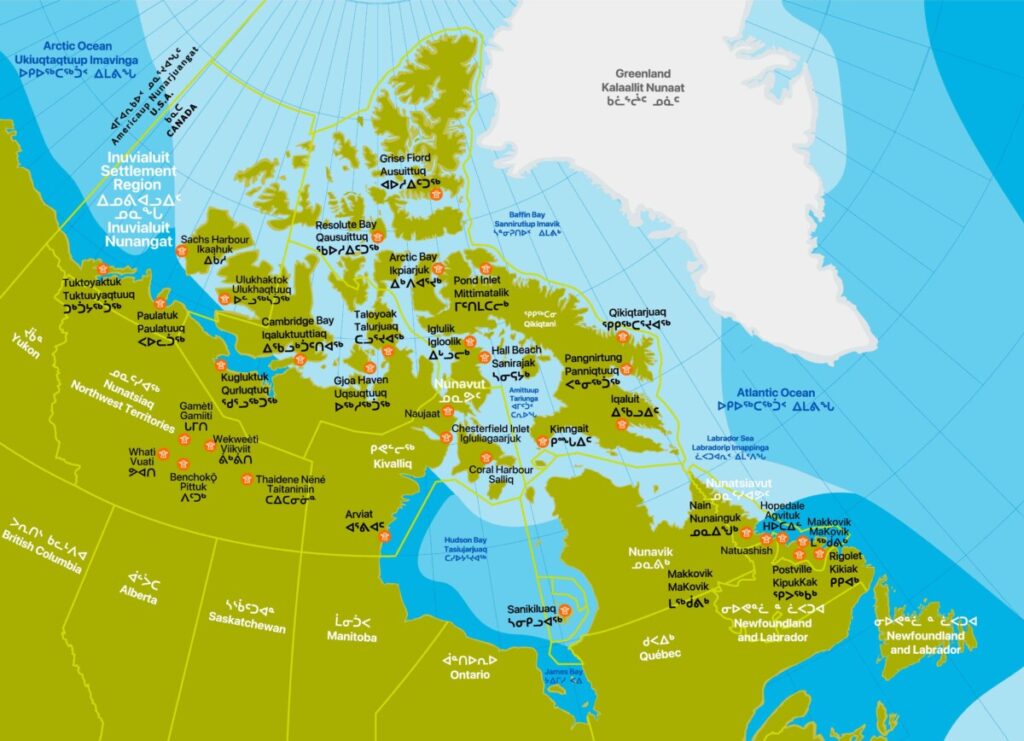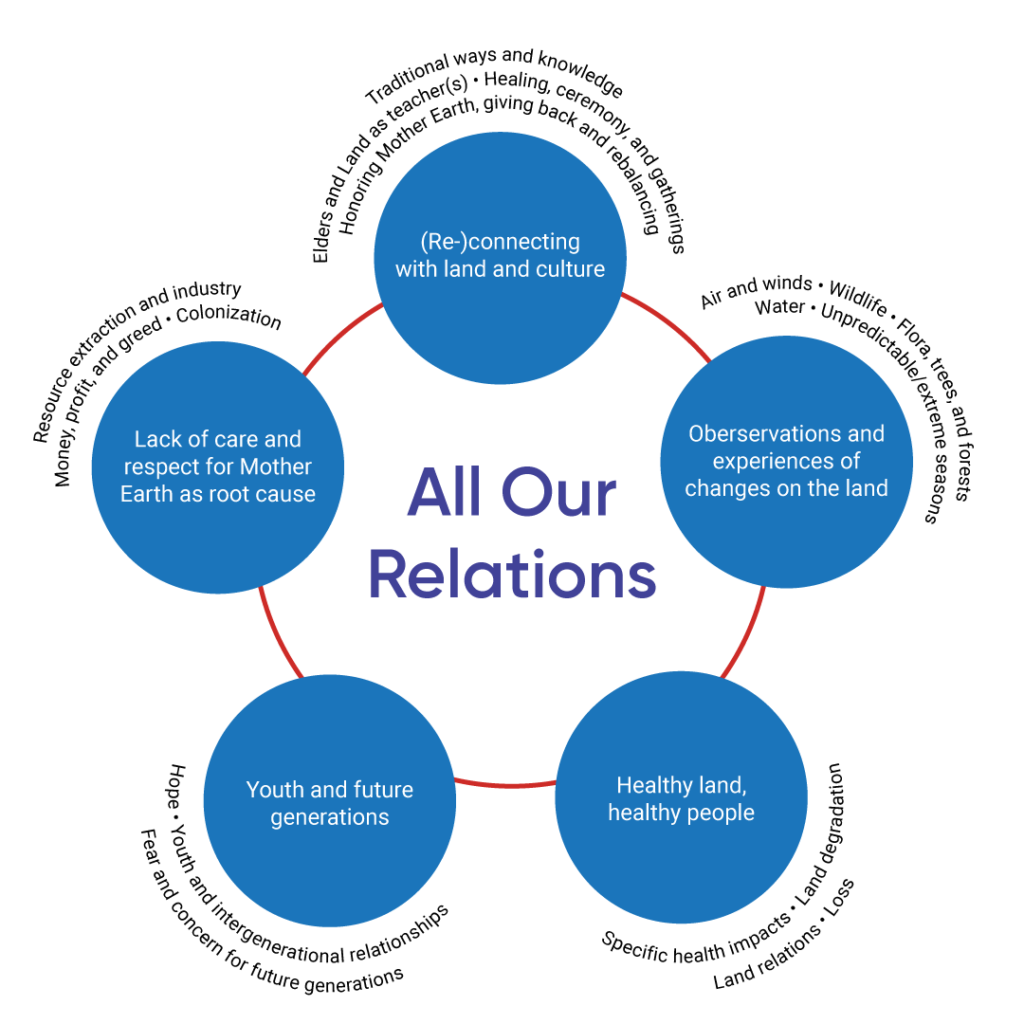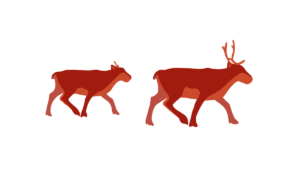Indigenous Peoples have often been portrayed as passive victims or harbingers of climate change impacts in domestic and international dialogues (Indigenous Climate Action, 2021a; Belfer et al., 2017; Bunce et al., 2016; Cameron, 2012). However, this portrayal often overlooks the ways Indigenous Peoples have been observing, adapting and living reciprocally with our Lands, Waters and Ice for millennia (McGregor et al., 2020; McGregor, 2019). Cultural, spiritual and social connections of our Peoples to the Land, Water and Ice may increase our exposure and sensitivity to climate change impacts, but they also provide unique sources of strength, knowledge, understanding and resilience (Deranger et al., 2022; Hernandez et al., 2022; Reed et al., 2022; Galway et al., 2021).
Canada’s approach to including Indigenous Peoples in climate change discussions has evolved over the past seven years, largely due to constructive relationships built with First Nations, Inuit and Métis organizations through senior-level bilateral tables created in the wake of the Pan-Canadian Framework, as well as through Indigenous advocacy (e.g., emergency declarations, the Indigenous Guardians Program, Indigenous Protected and Conserved Areas) (Reed et al., 2022; Gobby et al., 2021). This evolution has led to progressive commitments to an Indigenous climate leadership agenda. This agenda focuses on “…investing in the agency of Indigenous peoples and communities, supporting Indigenous-led and delivered solutions, equipping Indigenous peoples with equitable resources, and ensuring appropriate access to funding to implement self-determined climate action” (Government of Canada, 2020b, p. 69).
5.4.1 Indigenous climate emergency declarations and “All My Relations”
First Nations, Inuit and Métis have been actively leading and engaging in a wide range of activities to address climate change. These activities include education, land-based learning and healing (e.g., Ljubicic et al., 2021; McClain, 2021; Morales et al., 2021; Ward et al., 2021; Donatuto et al., 2020; Métisse Redvers, 2020; Mearns, 2017), Indigenous clean energy development (e.g., L’Hommecourt et al., 2022; Paquet et al., 2021; Indigenous Clean Energy, 2020), development of Indigenous Knowledge and science strategies (e.g., Huntington et al., 2021a; Sawatzky et al., 2021; Assembly of First Nations, 2020; Ferguson and Weaselboy, 2020; ITK 2019a, 2018; Jones et al., 2018), co-production of knowledge (e.g., Fox et al., 2020), adaptation planning and implementation (e.g., Galway et al., 2022) and political action and diplomacy, including treaty-based diplomacy (e.g., Callison, 2021, 2014; Kronk Warner and Abate, 2013; Grossman, 2008). A growing number of Indigenous Peoples have also released climate emergency declarations, calling for rapid de-carbonization to meet the targets of the Paris Agreement. For example, the declaration of the Vuntut Gwitch’in First Nation in Old Crow, Yukon, titled Yeendoo Diinehdoo Ji’heezrit Nits’oo Ts’o’ Nan He’ aa (After Our Time, How Will the World Be?), laid the foundation for First Nation Chiefs across Canada to declare a national climate emergency in 2019.
With support from the Vuntut Gwitch’in leadership, the First Nations-in-Assembly declared a First Nations Climate Emergency at the 2019 Assembly of First Nations, stating that “…climate change constitutes a state of emergency for our Lands, Waters, animals, and peoples” (Assembly of First Nations, 2019). The inclusion of more-than-humans in this declaration is emblematic of the relational approach that Indigenous Peoples have developed over millennia, also known as an ethic of “responsibility-based thinking” (Sioui and McLeman, 2014), which is broadly captured by the concept of “All My Relations” (or “sustainable relations” according to Ferguson and Weaselboy, 2020). This concept informs how Indigenous Peoples experience and understand the impacts of and approaches for adapting to climate change. Galway et al. (2022), in collaboration with Fort William First Nation Knowledge Holders, describe five sub-themes of their experiences with climate change organized using the “All My Relations” concept: 1) lack of care and respect for Mother Earth as a root cause; 2) (re)-connecting with Land and culture; 3) observations and experience of changes on the Land; 4) healthy Land, healthy people; and 5) Youth and future generations (see Case Story 2). The concept of “All My Relations” (see Figure 4) also acknowledges that Indigenous Peoples benefit from the strengths of all members, including the vital and unique contributions of our women, men, youth, Elders and 2SLGBTQQIA+ (see Box 4; Longman et al., 2020; Viscogliosi et al., 2020; Women’s Earth Alliance and Native Youth Sexual Health Network, 2016).
5.4.2 Indigenous rights and responsibilities
Central to strengths-based approaches is the recognition of the distinct status, roles and rights of Indigenous Peoples, affirmed in significant national and international human rights instruments, notably section 35 of the Canadian Constitution Act. Other instruments, such as the United Nations Declaration on the Rights of Indigenous Peoples (2007) and its subsequent adoption in provincial (British Columbia in 2019) and federal jurisdictions (Canada in 2021), affirm the rights of self-determination for Indigenous Peoples (Article 3 of the Universal Declaration of Human Rights). The concept of rights also considers the responsibilities that Indigenous Peoples carry when interacting with the more-than-human world. These responsibilities, as underlined by the human values that inform them, are one of the many contributions that Indigenous Peoples bring to the rest of humanity (IPCC, 2022; Cameron et al., 2021; Townsend et al., 2021; Salmón, 2000). Such a perspective stems from an understanding that human beings must learn to live with the Land, Water and Ice (McGregor, 2014; McGregor et al., 2010; Cajete, 1999).
These rights—and those affirmed in Treaties, land claims, agreements and other constructive arrangements (see Box 1)—have enabled Indigenous Peoples to take our rightful leadership roles in environmental governance, thereby advancing co-management arrangements and other stewardship activities (Cadman et al., 2022; Qikiqtani Inuit Association, 2021; Peacock et al., 2020; Snook et al., 2018a; Armitage et al., 2011). As a result, many Indigenous territories retain high levels of biodiversity and intact, critical and globally significant ecosystems (Schuster et al., 2019). Examples such as Indigenous Protected and Conserved Areas (IPCAs) (see Case Story 5.4 in NIR‑5) and Indigenous Marine Protected Areas (Imappivut Nunatsiavut Marine Plan, 2022) demonstrate how Indigenous Peoples are increasingly assuming leadership positions in governance and climate change action, as stewards of our traditional territories since time immemorial (McDonald, 2023; Reed et al., 2021b). Indigenous “resurgence” paradigms—where Indigenous Peoples are reclaiming our languages, ceremonies, teachings, governance and decision-making (Corntassel and Bryce, 2012)—draw on the strengths of traditional land-based culture and knowledge with regard to Indigenous leadership in land governance and stewardship (Alfred et al., 2015; Coulthard, 2014; Corntassel and Bryce, 2012; Simpson, 2011; Alfred, 2009; Alfred and Corntassel, 2005). Indigenous leadership in climate change policy, therefore, can ensure that the Indigenous right to self-determination is respected and upheld, allowing Indigenous Peoples to continue to carry out our cultural responsibilities to the Land for the benefit of all humanity (see Section 9.0; Powless, 2012).





